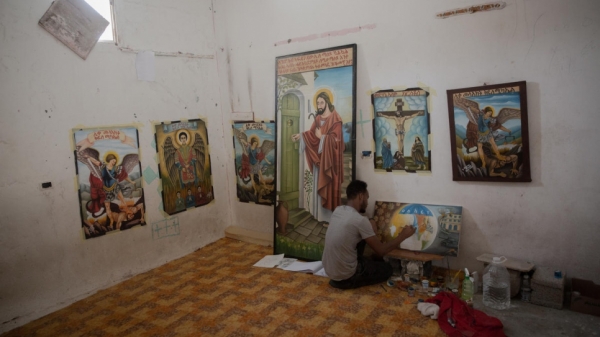The rusty, white walls of Solomon Alema’s room are covered in art. Five giant posters and one human-sized painting tower over the humble space. He’s sitting on the floor, dragging his paintbrush down to accentuate his new painting with color. There’s a cluster of clean sketchbooks and vibrant-colored art materials that surround him, illustrating a stark contrast to his dark-lit temporary shelter. For Solomon, his priority isn’t the state of his refugee life, but the safe haven he finds in the comfort of his art.
Solomon is a 29-year-old Eritrean refugee in Tripoli, Libya. He’s one of the 49,000 registered asylum seekers in Libya, but unlike the others, Tripoli isn’t his end destination. He envisioned a future as a hardworking student and a professional artist far from his home country, thrusting his mother to sell her jewellery and his relatives to support him through financial means. He paid smugglers $5,500 he had garnered to take him to Europe by boat, but halfway through the journey, the Libyan Coast Guard halted the vessel he was in, putting a stop to his ambitions.
After his release from detention, Solomon developed tuberculosis due to the unsanitary conditions and re-entered another detention center to access medical care that he couldn’t have availed on his own. Now, he resides in a community brimming with support and optimism despite the harsh conditions they’re in.
Access to basic essentials is still a figment of imagination to many. Solomon said that his housemates and friends were worried about the lack of food and financial security as they shared meals and other items among the group. “I honestly would prefer to spend everything I have on materials to paint. But life is very difficult and it is not easy to focus on painting when there are other really important things that are priorities for us, necessities for us to survive,” he said in the report of the United Nations High Commissioner for Refugees.
UNHCR provides asylum seekers and refugees financial, household, medical, and psychosocial support to make their needs meet. Together with the UN World Food Programme, the agency will provide food assistance to around 10,000 refugees and asylum seekers until the end of the year especially to those who lost their jobs due to the pandemic and cannot afford to provide for themselves.
While waiting for the said support, Solomon continues to immerse himself in his creative sphere. It’s obvious that there’s a pervasive theme that stands out in every artwork he paints. Each vividly-drawn creation is embellished with biblical motifs and references. “We don’t have any place to pray here in this country. So we use these pictures,” said Solomon. “When people pray, it gives them hope. Using this painting to pray helps them with their faith and makes them feel they are protected from danger.”
Art has paved a way for Solomon, who has no formal art training, to find the strength to wake up every day. Instead of keeping it to himself, he exposes it to his community to shower hope and light, inviting everyone to favor faith as a weapon against the hostile setting they live in.
Sources:
https://reporting.unhcr.org/node/12003#_ga=2.137798389.412294645.1593941709-892549232.1593359228
https://www.wfp.org/countries/libya
Author: Matthew Burgos







